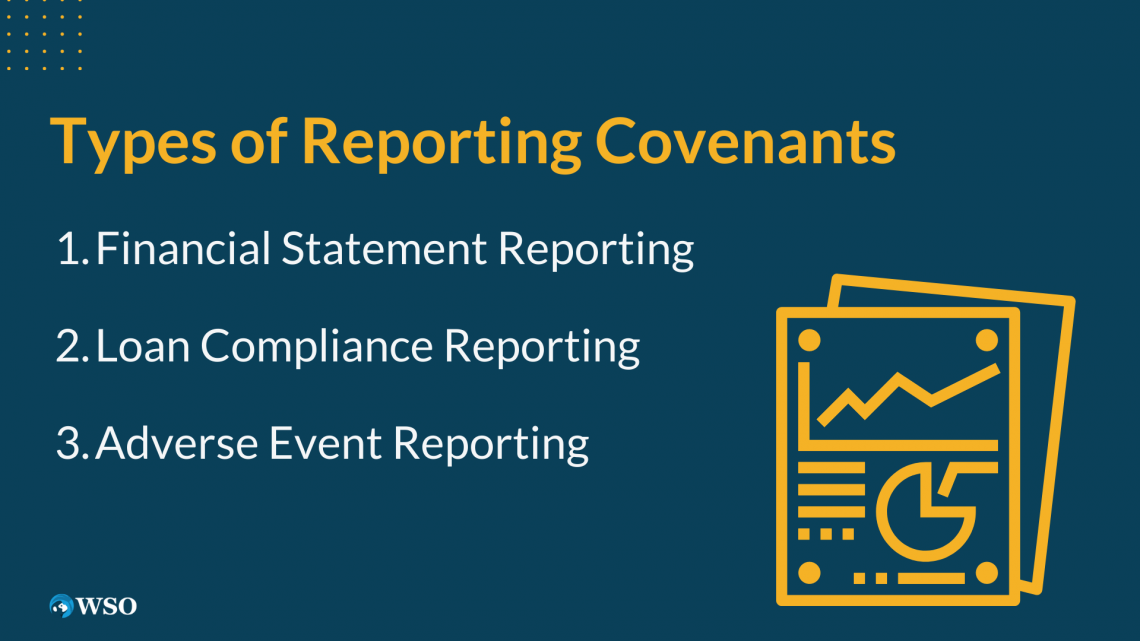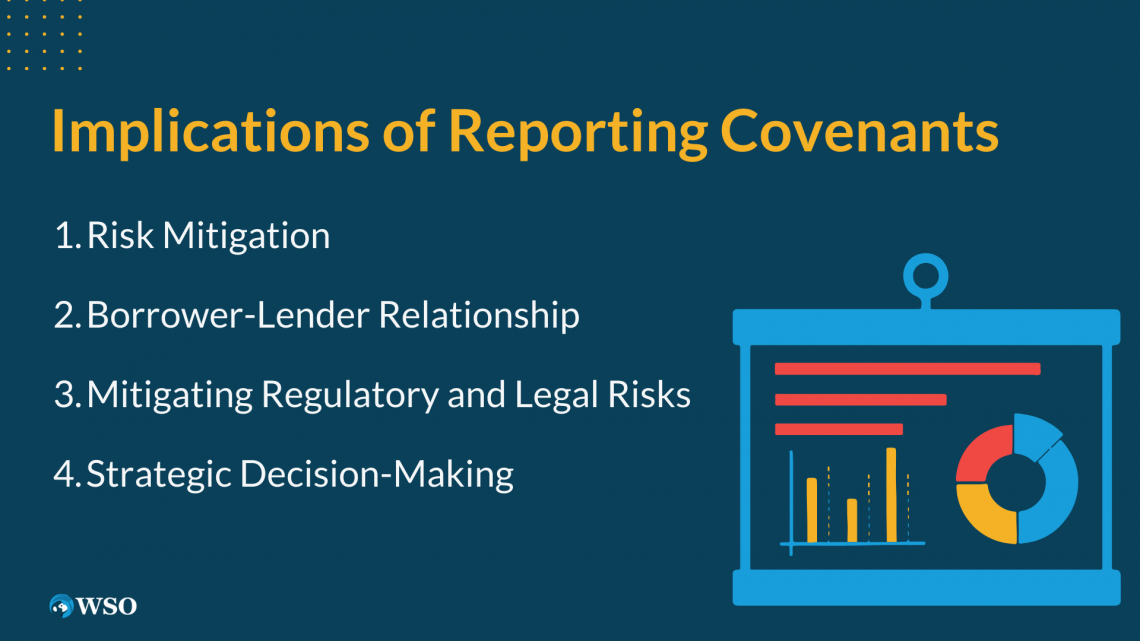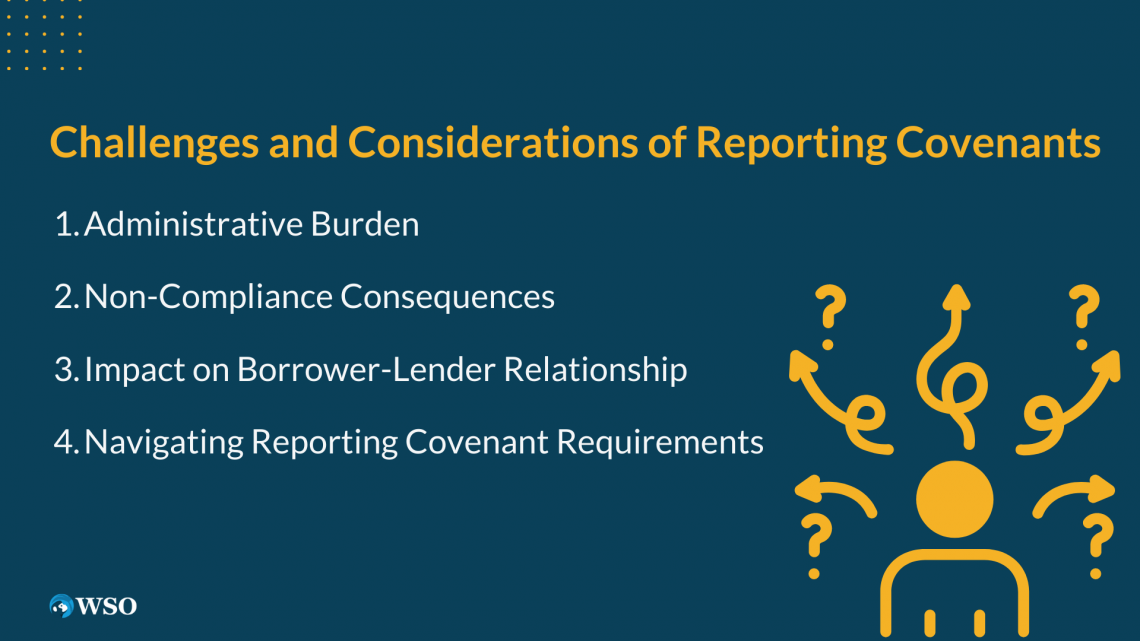Reporting Covenants
These are essential provisions in financial agreements that require borrowers to provide detailed financial and non-financial information to lenders regularly.
What are Reporting Covenants?
Reporting covenants are provisions included in financial agreements or loan contracts requiring the borrower to provide the lender with regular and detailed financial and non-financial information.

These covenants specify the reporting requirements, including the reports' frequency, format, content, financial statements, tax returns, operational metrics, or any other relevant information.
Reporting covenants ensure transparency and enable the lender to monitor the borrower's financial performance, assess compliance with loan terms, and identify any potential risks or issues in a timely manner.
Within the realm of covenants, various types exist, each tailored to fulfill specific objectives.
The primary type is financial statement reporting, which necessitates borrowers to furnish periodic financial statements encompassing comprehensive records of balance sheets, income statements, and cash flow statements.

This facet of covenants equips lenders with a holistic view of the borrower's financial standing, illuminating their profitability, liquidity, and overall fiscal viability.
Loan compliance reporting represents another significant facet of covenants. Within this framework, borrowers must report specific financial ratios or performance metrics to ascertain their adherence to the loan agreement.
By navigating the complexities of covenants with insight and understanding, stakeholders in financial agreements can cultivate an environment of trust, foster effective communication, and pave the way for successful financial partnerships.
Key Takeaways
- Reporting covenants are essential provisions in financial agreements that require borrowers to regularly provide detailed financial and non-financial information to lenders.
- These covenants enhance transparency and accountability, enabling lenders to monitor borrowers' financial performance, assess compliance with loan terms, and identify potential risks promptly.
- Different types of reporting covenants include financial statement reporting, loan compliance reporting, and adverse event reporting, each serving specific purposes in evaluating the borrower's financial health.
- Adhering to reporting covenants strengthens the borrower-lender relationship, mitigates regulatory and legal risks, and facilitates strategic decision-making for both parties.
- While reporting covenants offers numerous benefits, they also pose challenges such as administrative burdens, non-compliance consequences, and the need for careful navigation, necessitating effective planning and communication between borrowers and lenders.
Understanding the Significance of Reporting Covenants
These covenants act as a fundamental mechanism for lenders to diligently monitor the borrower's financial performance and strictly adhere to the agreed-upon loan terms.

Consequently, understanding the different types of covenants becomes essential for both borrowers and lenders, empowering them to navigate the complexities of financial agreements effectively and foster a mutually beneficial partnership.
We will now cover the ways in which reporting covenants help foster trust between borrowers and lenders, mainly through enhanced transparency, greater accountability, and by strengthening borrower’s self-assessment.
Enhancing Transparency
Reporting covenants hold profound significance within financial agreements among the various types of covenants. They are potent tools facilitating transparency, accountability, and ongoing communication between borrowers and lenders.
By mandating the regular submission of comprehensive financial information, reporting covenants create an environment of trust and enable lenders to gain valuable insights into the borrower's financial health and performance.

Regularly reporting financial information gives lenders a comprehensive view of the borrower's financial activities, enabling them to make informed decisions and assess risks effectively.
This knowledge empowers lenders to identify potential risks and vulnerabilities early on, allowing them to take proactive measures and provide necessary guidance and support to the borrower.
Establishing Accountability
Moreover, reporting covenants contribute to the establishment of a robust system of checks and balances between borrowers and lenders.

By consistently monitoring financial information, lenders can assess the borrower's compliance with loan covenants and promptly address deviations or potential breaches.
By maintaining open lines of communication and holding regular discussions based on the provided reports, borrowers and lenders can foster a more robust partnership built on transparency, trust, and accountability.
Strengthening Borrower’s Self-Assessment
In addition to benefiting lenders, reporting covenants also offer advantages to borrowers. By regularly reviewing and analyzing their financial information, borrowers gain a clearer understanding of their financial performance, strengths, and areas for improvement.
This self-assessment allows them to make informed business decisions, identify growth opportunities, and proactively address financial challenges.

Furthermore, the collaborative nature of reporting covenants encourages borrowers to seek guidance and support from lenders, who can provide valuable expertise and insights to help navigate potential obstacles or optimize financial strategies.
Reporting covenants play a vital role in financial agreements, fostering transparency, accountability, and ongoing communication between borrowers and lenders.
These covenants facilitate the regular submission of financial information, enabling lenders to gain valuable insights into the borrower's financial health and performance.
The knowledge obtained through reporting covenants empowers lenders to make informed decisions, assess risks, and provide necessary guidance and support.
Note
Simultaneously, borrowers benefit from a better understanding of their financial standing and the opportunity to seek expertise and support from lenders.
Types of Reporting Covenants
Reporting covenants encompass various provisions that borrowers must adhere to in financial agreements. Among these, reporting covenants stand as a fundamental category designed to maintain transparency and mitigate risks.

Whether a lender looking to safeguard an investment or a borrower seeking to understand obligations, understanding these covenants is essential for an effective financial relationship.
Financial Statement Reporting
Financial Statement Reporting is a fundamental reporting covenant requiring borrowers to provide periodic financial statements.
These statements typically include balance sheets, income, and cash flow statements, offering a comprehensive overview of the borrower's financial position.
By reviewing these records, lenders gain valuable insights into the borrower's financial stability, profitability, liquidity, and overall fiscal viability.
Note
This information enables lenders to assess the borrower's capacity to meet debt obligations, evaluate the risk involved, and make informed decisions about the partnership.
Loan Compliance Reporting
Loan Compliance Reporting focuses on specific financial ratios or performance metrics that borrowers must report demonstrating their adherence to the loan agreement.
These metrics serve as benchmarks for lenders to evaluate borrowers' financial health and gauge their ability to meet the loan terms.
By monitoring these metrics, lenders can assess the borrower's financial performance, identify deviations or potential breaches, and take appropriate actions.
Note
This reporting covenant helps maintain transparency and accountability, ensuring that both parties fulfill their obligations within the agreed-upon terms.
Adverse Event Reporting
Adverse Event Reporting is another essential component of reporting covenants. Borrowers must promptly notify lenders of significant adverse events or material changes that may impact their financial condition.
This provision enables lenders to stay informed about potential risks and challenges that could affect the borrower's ability to meet their obligations.
By promptly being aware of adverse events or material changes, lenders can assess the impact, evaluate the associated risks, and take appropriate measures to protect their interests.
This reporting covenant fosters open communication, allowing borrowers and lenders to work together to manage unexpected circumstances.
Note
Each type serves a unique purpose in facilitating transparency, evaluating financial health, and managing risks.
Implications of Reporting Covenants
The framework of covenants offers lenders a valuable tool for actively monitoring borrowers' financial situations, enabling early risk identification and mitigation. This approach fosters trust, stability, and sustainability in the borrower-lender relationship, benefiting both parties.

The next few points will cover the significance of the borrower-lender relationship, the role of covenants in mitigating regulatory and legal risks, and how accurate financial information enables strategic decision-making for both borrowers and lenders.
Risk Mitigation
Regular reporting under the covenants framework allows lenders to actively monitor the borrower's financial situation, facilitating early risk identification and mitigation.
By receiving timely financial statements and performance metrics, lenders can identify warning signs of potential financial distress or non-compliance with loan terms.
This early detection enables lenders to take proactive measures to address the situation, such as providing guidance, restructuring loan terms, or implementing corrective actions.
Through diligent assessment of potential risks, lenders can foster a sense of trust and confidence in the borrower-lender relationship, promoting a stable and sustainable financial environment.
Note
This proactive risk management approach ensures both borrowers' and lenders' continued success and mutual benefit.
Borrower-Lender Relationship
Adhering to covenants strengthens the borrower-lender relationship, establishing a solid foundation for a mutually beneficial partnership. By fulfilling reporting obligations, borrowers demonstrate their commitment to transparency, accountability, and good governance.
This proactive approach enhances trust and credibility, positioning the borrower as a reliable and responsible partner.
Lenders, in turn, appreciate the openness and communication fostered by covenants, allowing for a deeper understanding of the borrower's financial landscape.
Note
A solid borrower-lender relationship built on effective covenants paves the way for future collaborations, favorable lending terms, and access to additional financial resources.
Mitigating Regulatory and Legal Risks
Compliance with covenants helps borrowers mitigate regulatory and legal risks associated with financial agreements.
By fulfilling their reporting obligations, borrowers demonstrate their commitment to fulfilling contractual requirements and maintaining transparency.
This compliance reduces the likelihood of regulatory scrutiny, legal disputes, and potential penalties. Also, proper reporting can be evidence of good faith in case of legal or regulatory inquiries, bolstering the borrower's position and safeguarding their interests.
Strategic Decision-Making
The availability of accurate and timely financial information through covenants enables lenders to make strategic and informed decisions.
By comprehensively understanding the borrower's financial performance, lenders can assess creditworthiness, evaluate the need for additional financing, or explore expansion opportunities.
Note
By recognizing and embracing these implications, borrowers and lenders can navigate financial agreements with clarity, confidence, and mutual benefit.
Challenges and Considerations of Reporting Covenants
The main areas of focus are administrative burdens, consequences of breaching compliance, and the impact of covenants on borrower-lender relationships.

While reporting covenants are vital in maintaining financial accountability and transparency between lenders and borrowers, implementing and adhering to these agreements is challenging.
Balancing the demands of stringent reporting with the realities of business operations can lead to complications and potential conflicts.
From determining the level of detail in reporting to recognizing the operational impact, the complexities in setting up and complying with reporting covenants are multifaceted, such as:
1. Administrative Burden
Covenants place an added administrative burden on borrowers responsible for ensuring the accurate and timely preparation of financial reports.
This requires dedicated resources and a workforce to collect, compile, and present information to lenders.
2. Non-Compliance Consequences
Failing to meet covenant requirements can have severe consequences for borrowers. Lenders may impose financial penalties, restrict future financing options, or even declare a loan default, triggering the acceleration of payment or foreclosure proceedings.
Borrowers must understand and fulfill their reporting obligations to maintain a positive borrower-lender relationship.
3. Impact on Borrower-Lender Relationship
Covenants can significantly impact the borrower-lender relationship. Regular and accurate reporting fosters trust, transparency, and open communication.
Lenders rely on timely and reliable information to assess the borrower's financial health, make informed decisions, and provide ongoing support throughout the loan term.
4. Navigating Reporting Covenant Requirements
Successfully managing covenants requires careful planning and attention to detail. Borrowers should establish robust internal reporting systems, ensure compliance with reporting deadlines, and maintain open lines of communication with lenders.
It is advisable to seek professional guidance to navigate the complexities of covenant requirements and mitigate potential challenges.
While reporting covenants enhance transparency, promote risk mitigation, and strengthen borrower-lender relationships, they also present challenges such as administrative burden, confidentiality concerns, and the potential consequences of non-compliance.
Note
By understanding these challenges and considering the necessary measures, borrowers can effectively navigate reporting covenant requirements and maintain a positive and mutually beneficial relationship with lenders.
Conclusion
Reporting covenants promote transparency, accountability, and risk mitigation in financial agreements. They give lenders a holistic view of the borrower's financial standing, illuminating their profitability, liquidity, and overall fiscal viability.

These covenants establish a framework for regular financial reporting, which enhances communication and fosters a healthy borrower-lender relationship.
Borrowers must approach covenants carefully, as they impose obligations and challenges requiring accurate and timely financial report preparation.
By fulfilling these obligations, borrowers can build trust with lenders and demonstrate their commitment to financial responsibility.
On the other hand, lenders are responsible for exercising diligence in monitoring and interpreting the information provided through covenants. This helps protect the lender's interests and allows for timely intervention in case of financial distress.

A comprehensive understanding of covenants is essential for both borrowers and lenders. It enables them to navigate these agreements successfully and leverage the benefits they offer.
Ultimately, covenants contribute to the overall stability and growth of the financial ecosystem. By upholding transparency, accountability, and effective risk management, these covenants create an environment conducive to sustainable financial practices.
Borrowers and lenders need to maintain open lines of communication, seek professional guidance when needed, and work together to ensure the successful implementation and adherence to reporting covenants.
With a collaborative approach, financial stakeholders can foster financial stability, build trust, and unlock opportunities for growth and success.




or Want to Sign up with your social account?